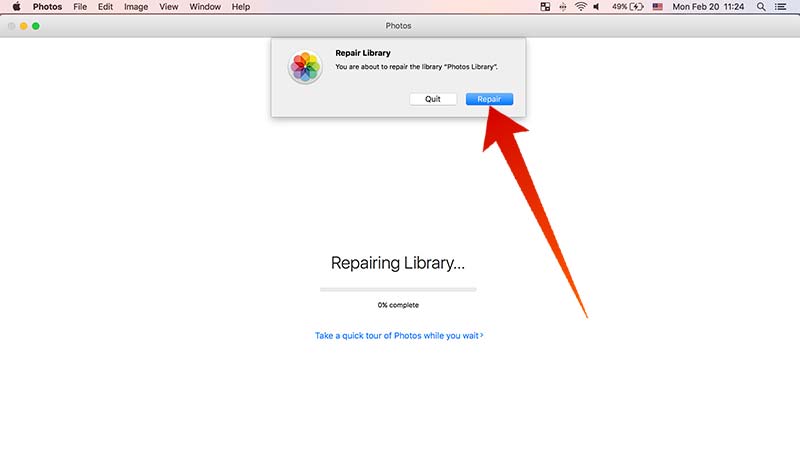Jul 12, 2017 During the trial install, the Mac freezes and requires a hard shutdown. After restart, the user no longer has permissions to their entire home folder and they get a pop-up 'macOS needs to repair your library to run applications'; however their password doesn't work to complete that process. Mar 08, 2017 'macOS needs to repair your Library to run applications. Type your password to allow this.' They just keep coming up. I've tried setting the permissions on the home and library directories, by doing a Get Info-Sharing & Permissions-Select User-Select Read & Write-Apply to Enclosed Items.
- Mac Os Needs To Repair Your Library To Run Applications
- Error Message Macos Needs To Repair Your Library To Run Applications
- Mac Os Needs To Repair Your Library To Run Applications Mojave
- Mac Os Needs To Repair Your Library To Run Applications 2017
Mac Os Needs To Repair Your Library To Run Applications
Your home folder contains many files and folders that apps on your Mac have permission to read or modify. If you use Get Info or other methods to change those permissions, you could experience issues such as these:
Error Message Macos Needs To Repair Your Library To Run Applications

- Mar 24, 2013 Question: Q: MAc OSX needs to repair your library to run applications More Less Apple Footer This site contains user submitted content, comments and opinions and is for informational purposes only.
- May 02, 2017 A few weeks back, I was using my computer over the weekend. When I was done I did what I always do, I locked theContinue readingmac os needs to repair your library to run applications.
- Mar 31, 2017 macOS needs to repair your library to run applications. Type password to allow this. (Sierra) So, I installed the new Sierra on my late 2013 iMac 27' and I'm getting this pop up: 'macOS needs to repair your library to run applications.Type password to allow this.
- Jul 05, 2017 Modern versions of Mac OS X no longer need you to repair disk permissions.However, that’s not the only issue that can occur with a disk or file system. Mac OS X contains a variety of tools for repairing disk, partition, and file system errors.
- Changes that you make in System Preferences aren't saved after you quit System Preferences.
- Changes that you make to the Dock aren't saved after you log out of your user account.
- Windows that were open the last time you logged out or quit an app (before you changed permissions) open again after you log in or open the app.
- You're asked for an administrator name and password when moving certain items in the home folder.
- You repeatedly get a message that macOS needs to repair your Library to run applications.
- When saving changes to an item, you get a message that the file is locked or you don't have permission to save.
- Preview, TextEdit, or other sandboxed apps unexpectedly quit when opened.
- You get an alert that the startup disk has no more space available for application memory.
- Activity Monitor shows that Safari or SafariDAVClient is using a large amount of system resources.
- Your Mac performs slowly.
- iTunes says that your device cannot be synced.
- Photos and videos that you import into Photos or iPhoto don't appear within the app, but do appear in Finder. Or your library needs to be updated or reselected each time you open Photos or iPhoto.
Reset permissions
Mac photo library management. Vs2017 image library. If the issue started after changing the permissions of items in your home folder , use these steps to reset permissions.
- Turn on or restart your Mac, then immediately press and hold Command (⌘)-R to start up from macOS Recovery.
- You might be prompted to enter a password, such as a firmware password or the password of a user who is an administrator of this Mac. Enter the requested password to continue.
- When you see the macOS Utilities window, choose Utilities > Terminal from the menu bar.
- Type
repairHomePermissionsin the Terminal window, then press Return. The Repair Home app opens. - Select your user account, click Next, then enter your administrator password. Click Next unlock the volume and begin resetting permissions on your home directory.
- When done, click Exit to return to the macOS Utilities window.
- Select Reinstall macOS, then click Continue and follow the onscreen instructions to reinstall macOS.
If the issue persists
Mac Os Needs To Repair Your Library To Run Applications Mojave
If resetting permissions doesn't resolve the issue:
Mac Os Needs To Repair Your Library To Run Applications 2017
- Make sure that you have a backup of your Mac, then erase your startup disk.
- When done, reinstall macOS.
- After installation completes and your Mac restarts to the setup assistant, create a new user account using a different name than the one you were using before. Any difference in spelling is enough.
- If you made a Time Machine backup, use Migration Assistant to restore all your files from the backup.